小学六年级英语四种时态复习总结.doc
小学英语4种时态总结表格
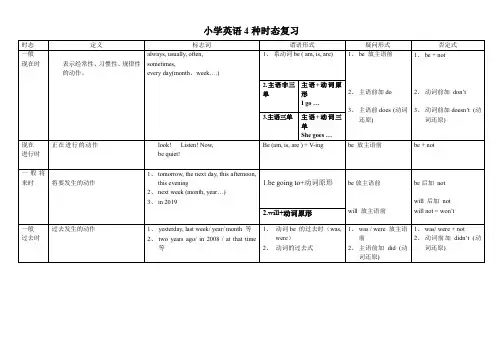
一般将来时
将要发生的动作
1、tomorrow, the next day, this afternoon, this evening
2、next week (month, year…)
3、in 2019
1.be going to+动词原形
be放主语前
will放主语前
be后加not
will后加not
2、主语前加did (动词还原)
1、was/ were + not
2、动词前加didn’t (动词还原)
will not = won’t
2.wபைடு நூலகம்ll+动词原形
一般
过去时
过去发生的动作
1、yesterday, last week/ year/ month等
2、two years ago/ in 2008 / at that time等
1、动词be的过去时(was, were)
2、动词的过去式
1、was / were放主语前
1、be + not
2、动词前加don’t
3、动词前加doesn’t (动词还原)
2.主语非三单
主语+动词原形
I go …
3.主语三单
主语+动词三单
She goes …
现在
进行时
正在进行的动作
look! Listen! Now,
be quiet!
Be (am, is, are ) + V-ing
be放主语前
小学英语4种时态复习
时态
定义
标志词
谓语形式
疑问形式
否定式
一般
六年级英语四大时态专项讲解
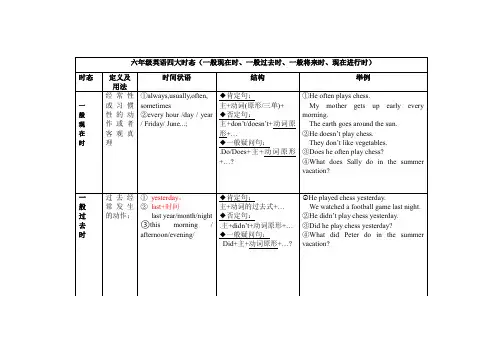
主+动词的过去式+…
◆否定句:
.主+didn’t+动词原形+…
◆一般疑问句:
Did+主+动词原形+…?
Heplayed chessyesterday.
We watched a football game last night.
②He didn’t play chessyesterday.
③Didhe play chessyesterday?
④What did Peter do in the summer vacation?
一
般
将
来
时
将要发生的动作;
1tomorrow+
Tomorrow morning/afternoon
2next+时间
nextweek/year/Friday
1.will
◆肯定句:
主+will+动词原形+…
◆否定句:
主+will + not+动词原形+…
◆否定句:
主+don’t/doesn’t+动词原形+…
◆一般疑问句:
.Do/Does+主+动词原形+…?
①Heoftenplays chess.
My mother gets up early every morning.
The earth goes around the sun.
②He doesn’t play chess.
◆一般疑问句:
Will +主+动词原形+…?
2.be going to
变化规则4大时态动词形式总结(知识清单)译林版英语六年级上册
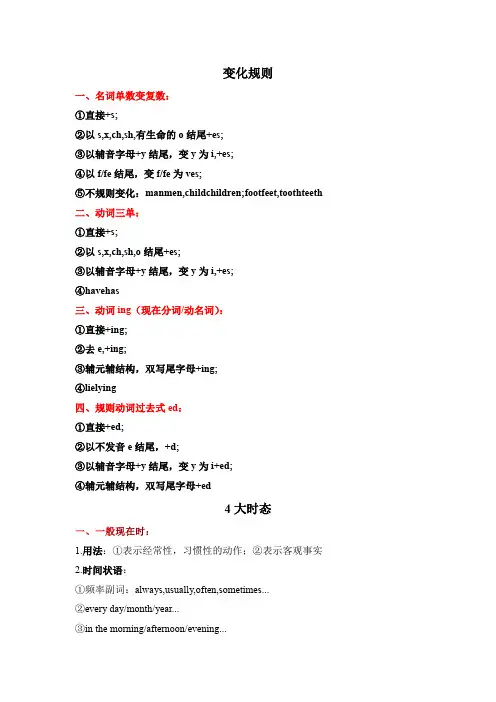
变化规则一、名词单数变复数:①直接+s;②以s,x,ch,sh,有生命的o结尾+es;③以辅音字母+y结尾,变y为i,+es;④以f/fe结尾,变f/fe为ves;⑤不规则变化:manmen,childchildren;footfeet,toothteeth 二、动词三单:①直接+s;②以s,x,ch,sh,o结尾+es;③以辅音字母+y结尾,变y为i,+es;④havehas三、动词ing(现在分词/动名词):①直接+ing;②去e,+ing;③辅元辅结构,双写尾字母+ing;④lielying四、规则动词过去式ed:①直接+ed;②以不发音e结尾,+d;③以辅音字母+y结尾,变y为i+ed;④辅元辅结构,双写尾字母+ed4大时态1.用法:①表示经常性,习惯性的动作;②表示客观事实2.时间状语:①频率副词:always,usually,often,sometimes...②every day/month/year...③in the morning/afternoon/evening...3.动词三单的变化规则:①直接+s;②以s,x,ch,sh,o结尾+es;③以辅音字母+y结尾,变y为i,+es;④havehaseg.She often gets up at six in the morning.1.用法:表示现在正在发生的动作(be+动词ing)2.时间状语:①now,at the moment...②Look! Listen!..③It’s ..o’clock.(Don’t talk.Where’s ...?)...3.动词现在分词的变化规则:①直接+ing;②去e+ing;③辅元辅结构,双写尾字母+ing;④lielyingeg.She is watching TV now.1.用法:①表示过去发生的动作;②表示过去存在的状态;③表示过去经常反复发生的动作;④表示已故的人所做的事情;2.时间状语:①...ago(two days ago;long long ago...)②last...(last year;last night...)③介词+时间名词(in 1999...)④yesterday;just now;then(那时...3.规则动词过去式的变化规则:①直接+ed;②以不发音的e结尾,直接+d;③以辅音字母+y结尾,变y为i,+ed;④辅元辅结构,双写尾字母+edeg.I saw a film last night.四、一般将来时:1.用法:①表示将来会发生的动作;②表示将来会存在的状态;2.构型:be going to do sth. / will+动词原形3.时间状语:①tomorrow及相关短语;②next..(next year/month/week..)eg.I am going to watch a film tomorrow.动词适当形式总结①在一般现在时里,主语不是三单,则用动词原形;②情态动词can,should,must+动词原形;③助动词Do/Does/Did... don’t/doesn’t/didn’t+动词原形④let sb. do sth. help sb. do sth.2.动词三单在一般现在时里,主语是三单,则动词用三单形式3.动词ing①现在进行时的构型:be+动词ing②go,like,be+动词ing;be good at/before/about/for(等介词)...+动词ing4.动词不定式(to do sth)①want/would like to do sth②what/how/which+to do sth③be+形容词(happy/sorry/nice...) to do sth④ask sb to do sth, use/reuse sth. to do sth。
六年级英语总复习(时态-语法)
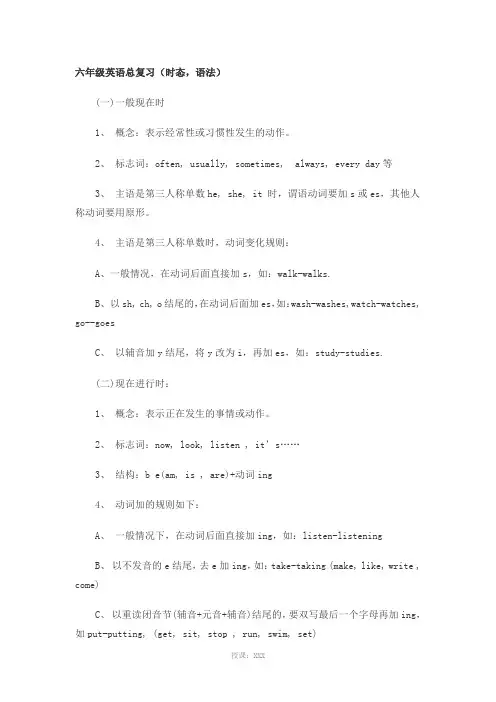
六年级英语总复习(时态,语法)(一)一般现在时1、概念:表示经常性或习惯性发生的动作。
2、标志词:often, usually, sometimes, always, every day等3、主语是第三人称单数he, she, it 时,谓语动词要加s或es,其他人称动词要用原形。
4、主语是第三人称单数时,动词变化规则:A、一般情况,在动词后面直接加s,如:walk-walks.B、以sh, ch, o结尾的,在动词后面加es,如:wash-washes,watch-watches, go--goesC、以辅音加y结尾,将y改为i,再加es,如:study-studies.(二)现在进行时:1、概念:表示正在发生的事情或动作。
2、标志词:now, look, listen , it’s……3、结构:b e(am, is , are)+动词ing4、动词加的规则如下:A、一般情况下,在动词后面直接加ing,如:listen-listeningB、以不发音的e结尾,去e加ing,如:take-taking (make, like, write , come)C、以重读闭音节(辅音+元音+辅音)结尾的,要双写最后一个字母再加ing,如put-putting, (get, sit, stop , run, swim, set)但:see-seeing, eat –eating.(三)一般将来时:1、概念:表示将要发生的事或打算,计划要做的事。
2、标志词:this weekend, next Monday, tomorrow, in seven years’ time3、结构:be(am, is , are) going to +动词原形或者 Will+动词原形如:I am going to take a trip next week.4、否定句:be+not going to +动词原形或者 Will+not(等于won’t)+动词原形(四)一般过去时:1、概念:表示在过去的时间里所发生的事或动作。
六年级下册英语素材 四种动词时态归纳及试题 全国通用
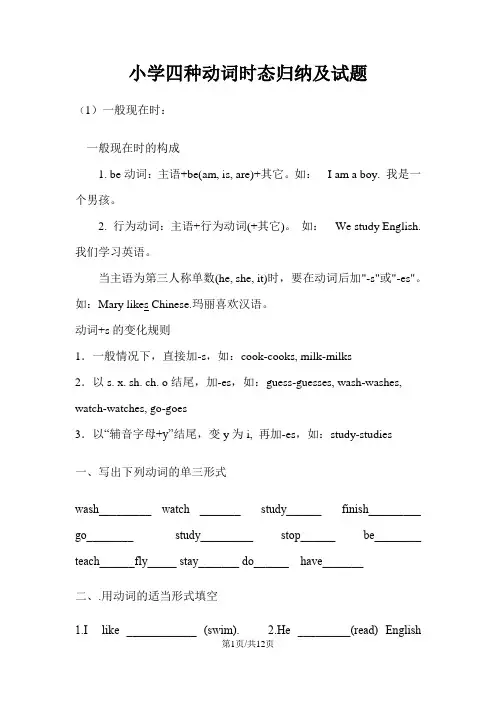
小学四种动词时态归纳及试题(1)一般现在时:一般现在时的构成1. be动词:主语+be(am, is, are)+其它。
如:I am a boy. 我是一个男孩。
2. 行为动词:主语+行为动词(+其它)。
如:We study English. 我们学习英语。
当主语为第三人称单数(he, she, it)时,要在动词后加"-s"或"-es"。
如:Mary likes Chinese.玛丽喜欢汉语。
动词+s的变化规则1.一般情况下,直接加-s,如:cook-cooks, milk-milks2.以s. x. sh. ch. o结尾,加-es,如:guess-guesses, wash-washes, watch-watches, go-goes3.以“辅音字母+y”结尾,变y为i, 再加-es,如:study-studies一、写出下列动词的单三形式wash_________ watch _______ study______ finish_________ go________ study_________ stop______ be________ teach______fly_____ stay_______ do______ have_______二、.用动词的适当形式填空1.I like ____________ (swim).2.He _________(read) Englishevery day.3.We ______(go)to school at seven in the morning.4.Mike_______(go)to school at seven in the morning.5.My mother_______(like) ______(go) shopping.6.I can ________(draw) many beautiful pictures.7. he________(like)_________(jump) ?8.The teachers (not like)__________(dance).9.The teacher (not like)_________(dance).10.The students___________(speak) English in class.11.The student_________(speak) Chinese after class.12. _______your sister (study) English at school ? No , she__________ . (not )三、用所给的人称改写句子1.I take photos on Sunday. ( Mike)2.We plant beautiful flowers. (she)3.They like playing basketball. (Ben)4.I listen to music every day. (my aunt)四、改句子1.Do you often play football after school? (肯定回答)2.Gao Shan's sister likes playing table tennis (改为否定句)3.She lives in a small town near New York. (改为一般疑问句)4.I watch TV every day. (改为一般疑问句)5.Nancy doesn't run fast.(肯定句)6.I usually play football on Friday afternoon. (否定句: 一般疑问句: 划线提问)●Su Yang usually washes some clothes on Saturday.(同11)●Tom does his homework at home.(同11)(2)一般过去时:动词过去式详解动词的过去式的构成规则有:A、规则动词①一般直接在动词的后面加ed:如worked , learned , cleaned ,visited①以e结尾的动词直接加d:如lived , danced , used①以辅音字母加y结尾的动词要改y为i再加ed(此类动词较少)如study – studied carry – carried worry – worried (注意play、stay不是辅音字母加y,所以不属于此类)① 双写最后一个字母(此类动词较少)如stoppedB、不规则动词(此类词并无规则,须熟记)小学阶段要记住以下动词的原形和过去式:sing – sang , eat – ate ,see – saw , have – had , do – did , go – went , take – took , buy – bought , get – got , read – read ,fly – flew , am/is – was ,are – were , say – said , leave – left , swim – swam , tell – told , draw – drew , come – came , lose – lost , find – found , drink – drank , hurt – hurt , feel – felt一、写出下列动词的过去式is\am_________have_______ plant________ are ________drink_________ play_______ go________ read ________does_________ dance________ worry________ sleep_____buy_________ eat__________ see________ take ______二、用动词的适当形式填空1. It ______ (be) B en’s birthd ay last Friday.2. We all ______ (have) a good time last night.3. I ______(be) an English teacher now.4. She _______(be) happy yesterday.5. _______ they ________ (clean) the room last Sunday? No, they _____.6. We ___________ (go) to school three days ago.7. What ____ you ______ just now? I _______ some housework. (do)8. He _________ (live) in Wu xi two years ago.9. The cat ________ (eat) a bird last night.10. We _______ (have) a party last Halloween.11. They ________ (play) chess in the classroom last PE lesson.三、句型转换1. They played football in the playground.否定句:________________________________________________一般疑问句:____________________________________________ 肯、否定回答:__________________________________________2. Nancy went to school early.否定句:________________________________________________一般疑问句:____________________________________________ 肯、否定回答:__________________________________________3. There was a car in front of the house just now.否定句:________________________________________________一般疑问句:____________________________________________ 肯、否定回答:__________________________________________ 肯、否定回答:__________________________________________(3)一般将来时:基本结构:①be going to + do;①will+ do. be going to = willI am going to go swimming tomorrow(明天). = I will go swimming tomorrow.一、改句子。
六年级英语毕业总复习概念(四个时态)
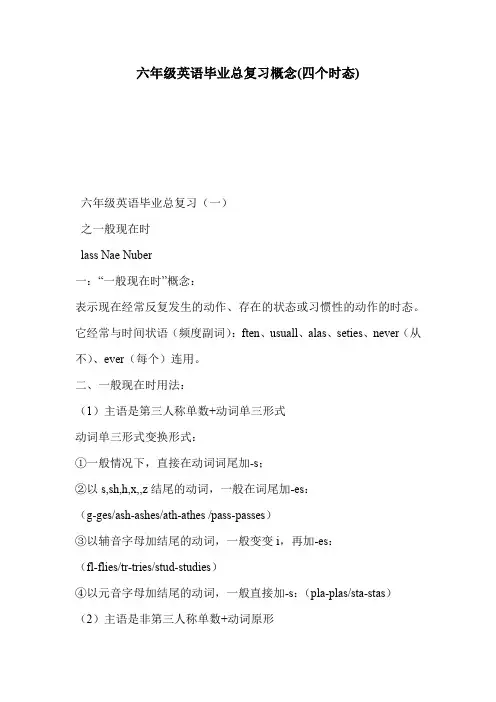
六年级英语毕业总复习概念(四个时态)六年级英语毕业总复习(一)之一般现在时lass Nae Nuber一:“一般现在时”概念:表示现在经常反复发生的动作、存在的状态或习惯性的动作的时态。
它经常与时间状语(频度副词):ften、usuall、alas、seties、never(从不)、ever(每个)连用。
二、一般现在时用法:(1)主语是第三人称单数+动词单三形式动词单三形式变换形式:①一般情况下,直接在动词词尾加-s;②以s,sh,h,x,,z结尾的动词,一般在词尾加-es:(g-ges/ash-ashes/ath-athes /pass-passes)③以辅音字母加结尾的动词,一般变变i,再加-es:(fl-flies/tr-tries/stud-studies)④以元音字母加结尾的动词,一般直接加-s:(pla-plas/sta-stas)(2)主语是非第三人称单数+动词原形三:一般现在时的否定形式:(1)、a/is/are+nt; I a a teaher I a nt a teaher(2)、此时态的谓语动词若为行为动词,则在其前加dn’t,如主语为第三人称单数,则用desn’t,同时还原行为动词。
The lie apples The dn’t lie applesShe lies apples She desn’t lie apples四:如何改一般疑问句:①把be动词放于句首;He is a student Is he a student?②用助动词d/des提问—动词还原—句末变问号。
☆还需注意细节变化:如-ur、an-an等。
The lie apples D the lie apples?She lies apples Des she lie apples?六年级英语毕业总复习(二)之一般过去时1.一般过去时表示过去某个时间发生的动作或存在的状态,常和表示过去的时间状语连用。
一般过去时也表示过去经常或反复发生的动作感谢。
(完整)小学六年级英语四种时态总结,推荐文档
小学六年级英语四种时态总结一、一般现在时标志词:always(总是) usually(通常) often(经常) sometimes(有时) never(从不) every(每一)行为动词词型变化形式一般现在时动词只有第三人称有词形变化,其他人称(第一人称:I, we;第二人称:you;第三人称复数:they、my friends)动词均用原形当主语是第三人称单数时,一般动词在一般现在时句子中的变化规律:1、多数在动词后加s play—plays like—likes ,2、以s,x,sh,ch,o结尾的动词加es wash–washes catch–catches do–does3、以辅音字母加y结尾,把y改i再加es fly—flies study—studies4、以元音字母加y结尾,直接加s buy – buys5、不规则变化have—has一般现在时基本用法功能1.表示事物或人物的特征、状态。
如:The sky is blue.天空是蓝色的。
2.表示经常性或习惯性的动作。
如:I get up at six every day.我每天六点起床。
3.表示客观现实。
如:The earth goes around the sun.地球绕着太阳转。
The earth is round.构成1. be动词:主语+be(am,is,are)+其它。
如:I am a boy.我是一个男孩。
2.行为动词:主语+行为动词(+其它)。
如:We study English.我们学习英语。
句型肯定句:A.be动词:主语+ be + 其它成分He is a worker.B.行为动词:主语+动词(注意人称变化) +其它成分We like the little cat.否定句:A.be动词:主语+ be + not +其它成分They are not students.B.行为动词:主语+助动词(do/does) + not +动词原形+其它成分We don’t like the little cat.一般疑问句:A.be动词:Am / Is /Are +主语+ 其它成分Are you a teacher? Yes, I am. / No, I am not.Are they students of your school.Yes they are / No they aren,t.B.行为动词:助动词(Do/Does)+主语+动词原形+ 其它成分Do you like it? Yes, I do. / No. I don’t .Does he(she) like it? Yes, he( she )does. / No, he ( she )doesn’t.特殊疑问句:疑问词+ 一般疑问句A.be动词:How many students are there in your school?B.行为动词:What do you usually do on Sunday?一般现在时动词be和have的变化形式1.动词Be 叫连系动词, 用法:第一人称单数用am,第三人称单数用is,其它人称用are。
小学六年级英语-时态总结
小学六年级英语-时态总结-CAL-FENGHAI.-(YICAI)-Company One1时态总结一、一般现在时标志词:always(总是) usually(通常) often(经常) sometimes(有时) never(从不) every(每一)行为动词的词型变化形式一般现在时动词只有第三人称有词形变化,其他人称(第一人称:I, we;第二人称:you;第三人称复数:they、my friends)动词均用原形当主语是第三人称单数时,一般动词在一般现在时句子中的变化规律: 1、多数在动词后加s play—plays like—likes ,2、以s,x,sh,ch,o结尾的动词加es wash–washes catch–catches do–does3、以辅音字母加y结尾,把y改i再加es fly—flies study—studies4、以元音字母加y结尾,直接加s buy – buys5、不规则变化 have—has一般现在时基本用法功能1.表示事物或人物的特征、状态。
如:The sky is blue.天空是蓝色的。
2.表示经常性或习惯性的动作。
如:I get up at six every day.我每天六点起床。
3.表示客观现实。
如:The earth goes around the sun.地球绕着太阳转。
构成1. be动词:主语+be(am,is,are)+其它。
如:I am a boy.我是一个男孩。
2.行为动词:主语+行为动词(+其它)。
如:We study English.我们学习英语。
句型肯定句:① be动词:主语+ be + 其它成分 He is a worker.②行为动词:主语+动词(注意人称变化) +其它成分 We like the little cat.否定句:①be动词:主语+ be + not +其它成分 They are not students.②行为动词:主语+助动词(do/does) + not +动词原形+其它成分We don’t like the cat.一般疑问句:①be动词: Am / Is /Are +主语 + 其它成分Are you a teacher Yes, I am. / No, I am not.Are they students of your schoolYes they are / No they aren’t.②行为动词:助动词(Do/Does)+主语+动词原形 + 其它成分Do you like it Yes, I do. / No. I don’t.Does he (she) like itYes, he (she) does. / No, he (she) doesn’t.特殊疑问句:疑问词+ 一般疑问句①be动词: How many students are there in your school②行为动词:What do you usually do on Sunday?一般现在时动词be和 have的变化形式1.动词Be叫连系动词, 用法:第一人称单数用am,第三人称单数用is,其它人称用are。
六年级英语时态总复习
六年级英语时态总复习一、现在进行时:表示现在正在进行的动作。
句子结构:主语+be动词+现在分词。
问句结构:疑问词+be动词+主语+现在分词。
否定句:在am,is ,are 后面加上not,is not=isn’t, are not=aren’t一般疑问句Be动词放在句首:如Are they playing football now?Yes,they are./No, they aren’t.时间词:now现在,Look看,看到这样的词,常用现在进行时。
如:Look,Danny is playing ping-pong.看,丹尼正在打乒乓球。
1.What are they doing now?他们现在正在做什么?They are playing football now.他们现在正在踢足球。
2.What is Li Ming doing ?李明正在做什么?Li Ming is playing basketball .李明正在打篮球。
3.What are you doing ?你正在做什么?I am doing exercise.我正在做锻炼。
4.Who is taking a picture?谁正在拍照?My brother is taking a picture.我的哥哥正在拍照。
注意:主语是You,They,复数时,be动词用are。
主语是单数,be动词用is。
主语是I,be动词用am。
二、一般将来时:表示未来要发生的动作。
句子结构:主语+be going to 或者will +动词原形。
问句结构:疑问词+be +主语+ going to+动词原形,或者疑问词+will+主语+动词原形。
常用的时间词:tomorrow明天,next week下周,next Saturday下周六,the day after tomorrow后天,否定句:am,is,are 后面加not,或者will后面加not,will not=won’t.一般疑问句:Be动词放在句首,或者Will放在句首。
外研版六年级上册英语第1、2天复习的四大时态
小学四大时态(一般现在时、现在进行时、一般将来时、一般过去时)一般现在时一般现在时:表示通常性、规律性、习惯性的状态或者动作(有时间规律发生的事件)的一种时间状态。
1.“经常发生的动作”,比如每天起床、吃饭、上学,一个星期去几次超市或新华书店等。
这些事件中,有的是有规律的,有的是偶尔做几次。
这些都算经常发生的事件。
我们要告诉人们的,是这个动作经常发生,是一般的情况而不是具体的某一次。
2.事物存在的状态。
3.有些动作或状态是永恒的,比如长江向东流、地球绕着太阳转,肯定式疑问式否定式否定疑问式I work. Do you work? I don't work. Don't you work? You work. Do you work? You don't work. Don't you work? We work. Do you work? We don't work. Don't you work? They work. Do they work? They don't work. Don't they work?He(She,It) w orks. Does he(she,it)work?He(She,It) doesn't work.Doesn't he(she it) work?基本用法1表示经常性或习惯性的动作或存在的状态2表示客观事实或普遍真理3在时间、条件等状语从句中,用现在时表示将来4在某些以here,there开头的句子中,用一般现在时表示正在发生的动作当主语是第三人称单数时:动词变相应的第三人称单数形式肯定句主语+动词s+其它否定句主语+doesn't+动词原形+其它一般疑问句Does+主语+动词原形+其它肯定回答Yes,主语+does否定回答No,主语+doesn't特殊疑问句特殊疑问词+一般疑问句一般现在时的分析当主语不是第三人称单数时:肯定句主语+动词原形+其它否定句主语+don't+动词原形+其它一般疑问句Do+主语+动词原形+其它要注意,句式结构错则全都错。
- 1、下载文档前请自行甄别文档内容的完整性,平台不提供额外的编辑、内容补充、找答案等附加服务。
- 2、"仅部分预览"的文档,不可在线预览部分如存在完整性等问题,可反馈申请退款(可完整预览的文档不适用该条件!)。
- 3、如文档侵犯您的权益,请联系客服反馈,我们会尽快为您处理(人工客服工作时间:9:00-18:30)。
四种时态复习一般现在时一般现在时的基本概念一般现在时表示现在经常反复发生的动作、存在的状态或习惯性的动作的时态。
常见的标志词(时间状语)主要有:every…, sometimes, at…, on Sundays, uauslly often, never, always等。
一般现在时的结构be动词的一般现在时主语+ Be动词+ 其他成分I am a boy.实义动词的一般现在时主语+ 行为动词+ 其他成分We study English.一般现在时的具体形式be动词的一般现在时1.第一人称单数I+amI am a student.2.第二人称单数you和其他人称复数we/you/they+areYou are a lucky girl.We are students in this school.3.第三人称单数he/she/it+isShe is my teacher.例题:用be动词的适当形式填空。
1.I from China.2.It very hot today.3.They in the hospital.4.We good students.5.She a beautiful girl.实义动词的一般现在时1.第一、二人称单数I/you和其他人称复数we/you/they+动词原形I get up at 8 o’clock.They go to school everyday.2.第三人称单数he/she/it+实义动词第三人称单数形式It runs fast.He studies hard.例题:用说给单词的适当形式填空。
1.We home every day.(go)2.Trees green in spring.(turn)3.He very hard.(study)4.The boy up at seven O'clock.(get)5.The earth round the sun.(move)补充:主语为第三人称单数形式,谓语动词的变化规则:状况变化规则发音例词一般情况加-s 清辅音后读【s】浊辅音和元音后读【/】swim-swims;help-helps;like- likes以o结尾的词加-es 读【z】go-goes;do-does 以s,sh,ch,x等结尾的词加-es 读【iz】watches以辅音字母+y结变y 为i再加es 读【z】study-studies尾的词不规则变化动词变have 为has变be为am, is, are have-hasbe-am, is, are一般现在时的句型变化be动词的一般现在时肯定句否定句He is a worker. 主语+ be动词+ not + 其他He is not a worker.一般疑问句特殊疑问句Be动词+ 主语+ 其他特殊疑问词+ 一般疑问句-Is he a worker?Where is he?-Yes, he is. / No, he is not.例题:写出下列句子中所缺的be动词,并用肯定及否定形式回答。
1.-- your father a teacher?--Yes, .No, .2.-- they in the room?--Yes, .No, .写出下列句子的否定句。
1.I am at home.2.Mr. Li is a professor.实义动词的一般现在时肯定句否定句I like bread. 主语+don’t/doesn’t+动词原形He often plays. I don’t like bread.He doesn’t often play.一般疑问句特殊疑问句Do/Does+主语+动词原形疑问词+一般疑问句–Do you like bread? What do you like?–Yes, I do. / No, I don’t. Where does he often play?–Does he often play?–Yes, he does. / No, he doesn’t.例题:将下列句子改写为否定句。
1.I have lunch at school.________________________________________________2.They play basketball on the playground.__________________________________3.Mr. Zhang knows French._____________________________________________一般现在时的基本用法1.表示人或物的特征He is a doctor.The dog is white and black.2.表示习惯性或经常性的动作,常与always, often, usauylly, seldom, everyday,sometimes, weekends,Mondays等表示时间与频率的词连用。
I leave home at 6 o’clock everyday.Tom always play football after school.We usually go to school by bus on Tuesdays.3.表示永恒不变的事实或真理Beijing is the capital of China.The snow is white.例题:用说给单词的适当形式填空。
1.He (have) blue eyes.2.We (go) to school everyday.3.We (have) no classes on weekends.4.She (write) a letter to her friend once a week.5.Tom (ride) a bike to school.6.Peter and Mary often (play) badminton together.7.Practice (make) perfect.一般将来时一般将来时的基本概念一般将来时表示将来某一时刻的动作或状态,或将来某一段时间内经常的动作或状态。
一般将来时由助动词shall(第一人称),will(第二、三人称)+动词原形构成。
一般将来时的结构主语+ will/ shall + 动词原形+ 其他部分We shall play this afternoon.He will have a lesson after lunch.一般将来时的具体形式第一人称I/ we + shall + 动词原形I shall be school in 10 minutes.We shall go to Beijing for our summer holiday.其他人称单复数+will+动词原形Tom will go swimming tomorrow.You will get well soon.They will come back this afternoon.例题:用说给单词的适当形式填空。
1.I (go) to the USA tomorrow.2.We (visit) her new week.3.The pilot (fly) to China the month after the next.4.It (take) us a long time to learn English well.5.He (be) there at seven tomorrow morning.一般将来时的句型变化肯定句否定句They will go to park this Sunday. 主语+will+not+动词原形They will not go to park this Sunday.一般疑问句特殊疑问句Will+主语+动词原形特殊疑问词+一般疑问句-Will they go to park this Sunday? Where will they go this Sunday?-Yes, they will. / No, they will not.例题:按要求改写句子。
Sam will move into new house next year.1..(改写为否定句)2.?(改写为一般疑问句)3.?(改写为特殊疑问句)注释:改写为特殊疑问句时,可根据句子的不同部分进行改写。
1. Sam will move into new house next year.Who will move into new house next year?2. Sam will move into new house next year.Where will Sam move into next year?3. Sam will move into new house next year.When will Sam move into new house?一般将来时的用法1.一般将来时表示将要发生的动作或情况。
I will(shall) get there tomorrow.Will you be free next weekend?We won’t (shan’t) be busy this evening.2.在以第一人称I或we作主语的问句中,一般使用shall,这时或是征求对方的意见,或是询问一个情况Where shall we have a meeting?Shall we have computer class tomorrow?3.be going to +动词原形,这个形式常用于表示打算,计划和安排好的事情We are going to have a trip next year.How are you going to spend your weekend?例题:选择正确的答案。
( ) 1. He very busy this week, he free next week.A. will be, isB. is, isC. will be, will beD. is, will be( ) 2. There a meeting tomorrow.A.wasB. is going to haveC. will haveD. is going to be( ) 3. --Where is the paper?--I it for you at once.A. getB. am gettingC. to getD. will get( ) 4. He him a beautiful bag next birthday.A. givesB. gaveC. will givingD. is going to give( ) 5. He in three days.A. coming backB. came backC. will come backD. is going to coming back现在进行时现在进行时的基本概念表示此时此刻正在进行的动作或事情。
